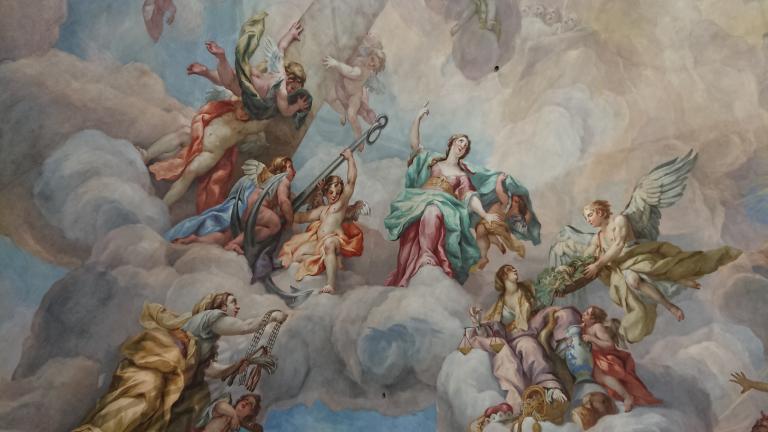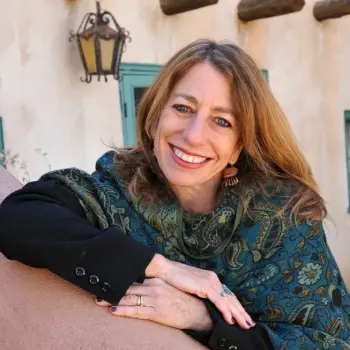
When you picture God, do you conjure up an image of a fatherly figure with long white hair and a beard? If you answer yes, there’s a pretty good reason for that. Attend a religious service at any church, synagogue, or mosque and, more often than not, you’ll find God referred to in strictly male terms.
You may be surprised to learn that in the three Abrahamic religions, Christianity, Judaism and Islam, God is not defined as a man or woman—but as a spirit with no physical substance. Neither male or female.
When talking about God, the Reverend Phillip A. Carl of Reston, Virginia, points out the conundrum in designating God’s gender. When delivering his sermons, he’ll often use the female pronoun as in: “Thanks be to God. She has blessed us with gifts too numerous to count.” But Carl writes that when he uses “She” to speak of God, he sometimes feels like he has put a “speed bump” between his listener and his intended message. He can sense his congregants thinking:
“She?” “Why’d he say she?” And then our minds go to remembering that God is neither male nor female and the only reason we think of her as a him is because, in antiquity, males were thought to be superior and, since God is superior, God must be male. Then our minds eye goes to Michelangelo’s portrait of God on the ceiling of the Sistine Chapel where “he” is a macho old white guy with fierce eyes and a very male beard.
I’ve Met God, She’s Black
You may have seen the message above on a T-shirt, social media post or on posters plastered around Manhattan. (If you haven’t, do a quick Google search and you’ll see it’s quite popular.) I’ve got to say that the first time I saw it, it stopped me in my tracks.
It is jarring in that it challenges our preconceived conceptions about who and what God is—something Mirabai Starr does masterfully in her latest book Wild Mercy, Living the Fierce and Tender Wisdom of the Women Mystics.
Starr pokes one hole after another in the notion that God should be thought of in masculine terms as she exposes us to the feminine side of the spiritual story. After all, if God has no gender, couldn’t God be represented by the image of a woman just as suitably as by the image of a man? Starr suggests it’s time to adjust our thinking:
Pretending God’s a dude hasn’t exactly worked out for the vast majority of the human family, let alone the animal and plant communities or the air or the waters.
Starr speaks out against “the toxicity of unbalanced masculine rule,” enlightening us to the female presence that can be found in all faiths and religions, across cultures and throughout history. In many ways, Starr’s Wild Mercy reads like a spiritual clarion call, not only to women who embody God’s feminine side, but to a growing number of men who are ready for a new and deeper understanding of God. Her call is to act and act now to realize the feminine aspect within all who are spiritual. In her words:
We are no longer willing to wait for invitations from men’s ancient elite clubs; we do not believe true spiritual experience is limited to these privileged spaces. Instead, we find the face of the Holy One in the faces of our babies and our lovers, our elders and our coworkers, the dirty dishes and the deep quiet that falls over our homes when everyone else is sleeping and we stand at the window, looking at the moon.
Starr shows us the power and love of the divine feminine.
She tells us about Sophia, the feminine goddess of wisdom found in ancient Greek philosophy and in Christian mysticism. She introduces us to the living Earth goddess Gaia. She teaches us about Julian of Norwich, a 14th-Century anchoress who declared that “just as God is our Father, so God is also our Mother.” According to Starr, Julian experienced Jesus as one who took “a personal interest in every single being, like a loving Mother, forgiving us when we screw up and rejoicing when we return to love.”
From Mother Mary to her own mother, Starr weaves a tapestry of her favorite teachings from women of wisdom past and present. This diverse line up includes Teresa of Ávila, Quan Lin, Kali, White Buffalo Calf Woman, and Our Lady of Guadalupe, to name just a few.
Starr also details her personal religious practices, including how she celebrates the Jewish day of rest, Shabbat. While the Christian Sabbath is observed on Sunday, Shabbat is observed from a few minutes before sunset on Friday until nightfall on Saturday. Starr tells us that Shabbat invites, welcomes and embodies the presence of the divine feminine here on Earth:
In the Jewish tradition, the holiest of holy days—holier than the High Holidays themselves is Shabbat, and she is female. Yes, the Sabbath itself is a feminine being. The Shekinah is the indwelling feminine presence of the Divine. She resides in exile during the rest of the week and on Shabbat she comes home.
Starr reveals, with her signature intimacy, that “on Shabbat, I slow down and remember to praise her (Shekinah) with my footsteps. I caress her with my breath. I thank her.” She suggests all of us set aside a regular day—once a week, a day a month, a weekend—as a personal Sabbath or Shabbat. We need to find our own way to put aside our daily concerns and let ourselves rest. “Read, write poetry, color in a coloring book, take a hike, make a beautiful meal—anything that reconnects you with your soul.”
Starr believes that the key to making these rituals have meaning in our own lives is repetition. In that way, they become a continuing reminder of who we are. She instructs us to “enact this ritual again and again, week after week. We are endlessly forgetting and remembering. In fact, we could look at all spiritual practices, all rituals and ceremonies and creative arts, as bells designed to wake us from the slumber of our separateness.”
Once we awaken, we will be better able to “engage in the very feminine values that have been missing from our religious and political institutions: the willingness to be present, to listen, and, most of all, to allow our hearts to be moved by the suffering of the world.”
So what does this mean to you? What actions can you take to apply these teachings to your own life? Mirabai Starr covers that as well, offering an invitation to join her in a contemplative adventure as “contemporary mystics masquerading as ordinary people.”
She reminds us that “we are all born with a particular task we are meant to contribute to the healing of the world, and we are precisely and perfectly designed to do it. She hints that “it is probably something you are already good at and is almost definitely something you love doing.” She asks us to consider: What is the unique task imprinted on your soul?













